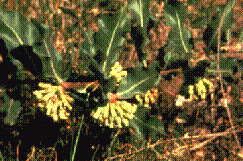Green Milkweed (Asclepias viridiflora)

Found nearly throughout North Dakota, green milkweed occurs in southeastern Canada and from Connecticut to Montana south to Georgia and northeastern Mexico, at elevations up to 6,000 ft. Green milkweed is perennial from a vertical rootstock. Stems are mostly solitary or in pairs, and are up to two feet tall. Leaves are usually opposite, up to four inches long, and extremely variable in shape. Plants from dry sites tend to have long narrow leaves, whereas those from moist sites are nearly round. About 20-80 pale green flowers occur in clusters. These are about two inches in diameter and are found in the upper leaf axils. Milkweed flowers have a special mechanism to trap insect legs and cause pollen masses to be pulled from the plant. The four-inch long pods of green milkweed are pointed at both ends and lack the warts or tubercles found on our larger common milkweed.
Look for green milkweed on dry hills or slopes in sandy or rocky native prairie or dry upland woods. The plant has been found under all grazing regimes. Many milkweeds are used for fiber, medicines, gums, and foods, but I could find no references to economic uses of green milkweed.
Most of the roughly 2400 species in the milkweed family (Asclepiadaceae after Asklepios the Greek god of medicine) are found in Africa and tropical America. There are about 100 species of Asclepias; most are found in the Americas. The specific epithet viridiflora means "green-flowered" in botanical Latin.
Green milkweed was described for science in 1808 by the brilliant, but quite eccentric, naturalist from Constantinople Constantine Samuel Rafinesque (1783-1840). This controversial botanist authored many Latin binomial names for plant "species" that remain quite untraceable.
![]()
 Wildflower
Seed For Sale
Wildflower
Seed For Sale